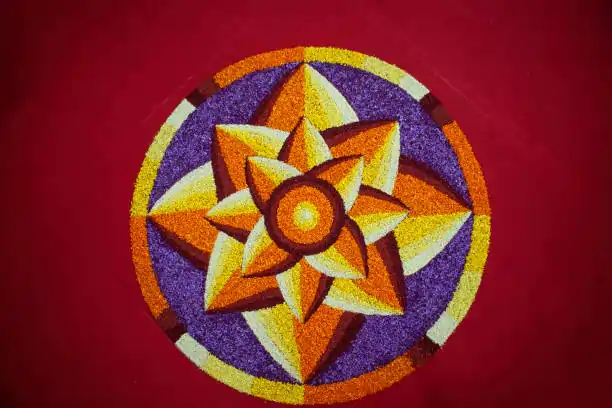Kavya Bhardwaj
India is not just a country. It is a living, breathing civilization—ancient yet ever-evolving, diverse yet deeply interconnected. Every corner of this sacred land echoes with distinct identities, languages, facial features, skin tones, foods, and dress styles—each as vibrant and rooted. What may seem to an outsider as mere variety is, to us, a sacred unity. A blessing. A heritage of unspeakable depth.
To be Indian is to embody contradictions that harmonize—languages spoken in a thousand dialects, food seasoned with the essence of soil and soul, textiles woven with memory and myth, and art forms that do not just entertain but teach, heal, and sustain. Every traditional practice in India—be it the architecture of a temple, the stitching of a sari, or the rhythm of a folk song—carries a philosophical thread which is same throughout india. Sustainability was never a trend in India—it was our way of being.
Our art forms, they are continuations of a way of life that values the sacredness of all beings. They don’t belong to any one religion, caste, or region—they belong to India. And India belongs to everyone who embraces her essence.
Yes, the cultural roots of India are deeply connected to Hinduism—its philosophies, its festivals, its stories, its legends —but Indian culture is not exclusive to Hindus. It is inclusive, expansive. One may follow any religious path, yet still drape a handloom kurta, eat on a banana leaf, or chant a verse from the Gita, and be as Indian as any other. Our cultural identity is Indian; our religious identity is personal. The two must not be confused, nor should pride in one turn into supremacy over others.
A chauvinistic approach—be it for one’s language, religion, or region—diminishes the beauty of this shared legacy. I say this as someone whose roots flow across three different states of India—. I do not belong to just one place. I belong to all of them. Every folk dance, every script, every spice feels mine.
This inclusivity makes it easier to feel the pulse of every region, to see each as a different color in the same rangoli. To know India is to travel through her, not just geographically but emotionally and historically.
And in this journey, one begins to feel a profound gratitude to our ancestors—visionary rulers, sages, scholars, and warriors—especially from the South, who stood guard against centuries of cultural erosion. It is not by accident that India still sings the songs of her ancient soul. It is the result of sacrifice, wisdom, and resilience.
Around the world, we see the loss of indigenous identity under foreign rule. But India endured. We are here not just as survivors of history, but as carriers of the oldest living civilization. Not to dominate the world, but to serve as a light. To be humble, to be grateful, and to take pride—not arrogant pride, but rooted pride—in who we are.
And as I dive deeper into the history of Bharat, I realize how we were targeted for simply being different—for holding on to traditions the world did not understand. But now, more than ever, we must understand it ourselves. We must reclaim our narratives, not in opposition to others, but in connection to ourselves.
Let us begin to feel our uniqueness. Let us embrace our knowledge systems. Speak our mother tongues, wear our weaves, cook our age-old recipes, and celebrate every dance of this soil. Let every Indian feel that their story is part of a grand, interconnected epic.
Only then will India truly shine—not as a borrowed idea, but as a civilization standing in its full authenticity.
The idea of unity in diversity is not a modern innovation for India—it is a timeless, foundational value rooted in the very core of Hindu philosophy and the broader Indian knowledge systems. While this principle may seem progressive or recently adopted in some parts of the world, especially in the West, it has always been intrinsic to the Indian worldview.
India’s astonishing diversity—linguistic, religious, cultural, philosophical, and ecological—is not accidental. It is the natural expression of a civilization built on the understanding that truth is multifaceted, and paths to realization are many. This is reflected in Rig Vedic insights such as Samānī va ākuṭiḥ samānā hṛdayāni vaḥ, samānam astu vo mano yathā vaḥ susahāsati” Let your aims be common, your hearts be common, and your mind be common… so that you may live well together with physical uniqueness, which honors pluralism not as a compromise, but as a divine design.
The Indian subcontinent, with its vast geography—ranging from the Himalayas to coastal plains, deserts to rainforests—has nurtured a wide variety of practices and ways of life. The sages and seers (rishis) of ancient India recognized this multiplicity not as a threat, but as a reflection of Dharma, which adapts to desha, kala, and patra (place, time, and context).
Any chauvinism, sectarianism, or regional supremacy within this diversity is a distortion—a corruption—of this original spirit. It forgets that the Indian idea of nationhood is not built on homogeneity, but on harmony of differences, rooted in spiritual universality.
To be Indian in the deepest sense is to recognize and celebrate this plurality as sacred, not to erase it under the illusion of one true way. The unity of India is not despite its diversity—it exists because of it.
And what a gift it is—to be Indian.





